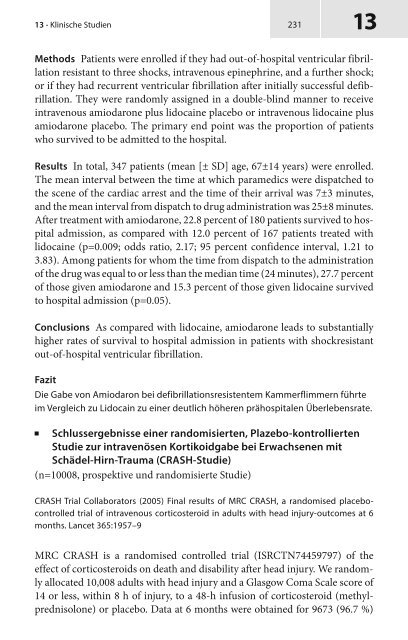Intensivmedizin Fragen und Antworten
Sie wollen auch ein ePaper? Erhöhen Sie die Reichweite Ihrer Titel.
YUMPU macht aus Druck-PDFs automatisch weboptimierte ePaper, die Google liebt.
13 · Klinische Studien<br />
231<br />
13<br />
Methods Patients were enrolled if they had out-of-hospital ventricular fibrillation<br />
resistant to three shocks, intravenous epinephrine, and a further shock;<br />
or if they had recurrent ventricular fibrillation after initially successful defibrillation.<br />
They were randomly assigned in a double-blind manner to receive<br />
intravenous amiodarone plus lidocaine placebo or intravenous lidocaine plus<br />
amiodarone placebo. The primary end point was the proportion of patients<br />
who survived to be admitted to the hospital.<br />
Results In total, 347 patients (mean [± SD] age, 67±14 years) were enrolled.<br />
The mean interval between the time at which paramedics were dispatched to<br />
the scene of the cardiac arrest and the time of their arrival was 7±3 minutes,<br />
and the mean interval from dispatch to drug administration was 25±8 minutes.<br />
After treatment with amiodarone, 22.8 percent of 180 patients survived to hospital<br />
admission, as compared with 12.0 percent of 167 patients treated with<br />
lidocaine (p=0.009; odds ratio, 2.17; 95 percent confidence interval, 1.21 to<br />
3.83). Among patients for whom the time from dispatch to the administration<br />
of the drug was equal to or less than the median time (24 minutes), 27.7 percent<br />
of those given amiodarone and 15.3 percent of those given lidocaine survived<br />
to hospital admission (p=0.05).<br />
Conclusions As compared with lidocaine, amiodarone leads to substantially<br />
higher rates of survival to hospital admission in patients with shockresistant<br />
out-of-hospital ventricular fibrillation.<br />
Fazit<br />
Die Gabe von Amiodaron bei defibrillationsresistentem Kammerflimmern führte<br />
im Vergleich zu Lidocain zu einer deutlich höheren prähospitalen Überlebensrate.<br />
jSchlussergebnisse einer randomisierten, Plazebo-kontrollierten<br />
Studie zur intravenösen Kortikoidgabe bei Erwachsenen mit<br />
Schädel-Hirn-Trauma (CRASH-Studie)<br />
(n=10008, prospektive <strong>und</strong> randomisierte Studie)<br />
CRASH Trial Collaborators (2005) Final results of MRC CRASH, a randomised placebocontrolled<br />
trial of intravenous corticosteroid in adults with head injury-outcomes at 6<br />
months. Lancet 365:1957–9<br />
MRC CRASH is a randomised controlled trial (ISRCTN74459797) of the<br />
effect of corticosteroids on death and disability after head injury. We randomly<br />
allocated 10,008 adults with head injury and a Glasgow Coma Scale score of<br />
14 or less, within 8 h of injury, to a 48-h infusion of corticosteroid (methylprednisolone)<br />
or placebo. Data at 6 months were obtained for 9673 (96.7 %)


